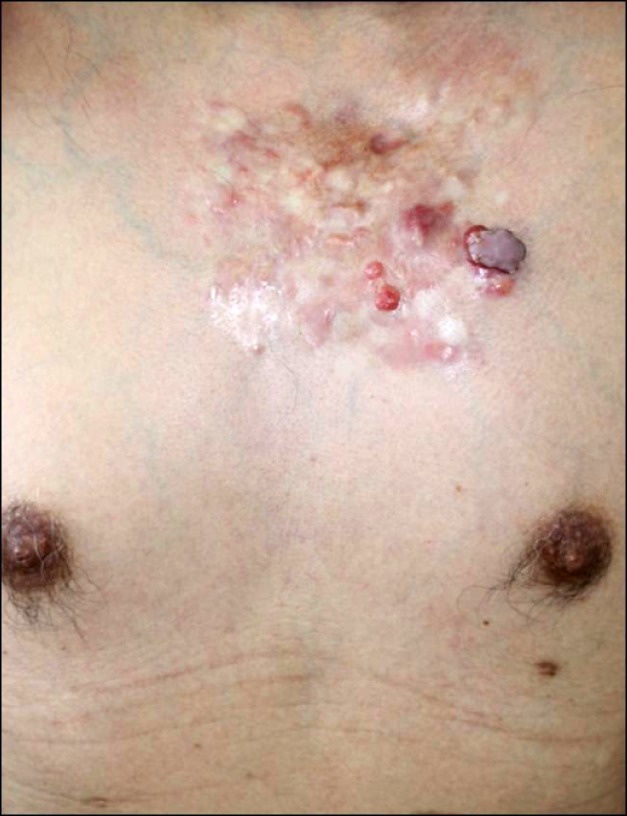Dear Editor:
Dermatofibrosarcoma protuberans (DFSP) is regarded a locally invasive, low-grade sarcoma. DFSP is typically characterized by its protuberant appearance. The DFSP in our patient had a clinically heterogeneous appearance, which is very rare, so the DFSP was initially misdiagnosed as a keloid.
A 46-year-old male presented with a progressing skin lesion on his anterior chest. The erythema with itching had developed in his 20s, and the nodules appeared gradually. The nodules were thought to be keloids, so he received intralesional steroid injections for a few years at a dermatological clinic. However, that therapy had little effect, and he was referred to our department. He presented with an 8.0×10.0-cm shiny, atrophic skin-colored plaque, in which indurated erythema and painful keloid-like nodules were observed (Fig. 1). These nodules were also found on his chest area. The atrophic plaque (Fig. 2A), erythema (Fig. 2B), and nodule (Fig. 2C) were biopsied.
Fig. 1.

Clinical features of the 3 different lesions: shiny atrophic plaque (8.0×10.0 cm), indurated erythema, and painful, keloid-like red nodules (largest nodule: 2.0×1.5 cm) on the anterior chest.
Fig. 2.
Histopathological features of the lesions (H&E, ×200). Atrophic plaque (A); a few proliferating spindle cells are seen (B). Erythematous plaque (C); storiform pattern is evident, but cellularity is low (D). Keloid-like nodule (E); typical pathological findings of DFSP; the cells show a storiform pattern, which is the dominant pattern, and infiltration into the subcutis. Cellularity is the highest in this lesion (F).
Histologically, the 3 samples showed common basic structures. The epidermis consisted of atrophic and spindle-shaped cells, showing little atypism; the cells proliferated in a storiform pattern throughout the dermis and even extended to the lobular structures of fatty tissue. The tumor cells were CD34 positive.
To identify the histological differences according to clinical status, we examined the cellularity and positive staining rates for Mib-1 in the atrophic plaque, erythema, and nodule. The cellularity count for each sample was performed in 10 randomly selected areas at high magnification (×200). The degree of cellularity in the nodular lesion (Fig. 2F) was higher than that in the other lesions (Fig. 2D, E). The mitotic index was similar among the 3 lesions.
Later, the tumor was resected along the planned 3-cm margin. The overlying skin defect was reconstructed using a flap from the greater pectoral muscle. At the follow-up after 2 years, the patient was found to be free of the disease.
DFSP is typically characterized by its protuberant appearance during early or middle adulthood. However, several cases of clinical and pathological unusual variants, such as Bednar's tumor and myxoid, sclerosing, fibrosarcomatous, atrophic, and nonprotuberant DFSP have been reported1. Our patient showed unique and various clinical features in a single location, including atrophic plaque, indurated erythema, and keloid-like nodules. What factors cause these different clinical appearances?
The atrophic variant of DFSP is most commonly found on the trunk of women2. Furthermore, atrophic DFSP is more common among children and young adults3 than among the elderly. Martin et al.4 reported a nonprotuberant form of DFSP, and nearly half of their patients identified their early DFSP-related skin changes as patches, and the nonprotuberant stage lasted for 7.6 years. In those cases, the clinical appearance of the lesions resembled that of morphea, morpheaform basal cell carcinoma, atrophoderma, or angioma lesions. The COL1A1-PDGFB fusion gene is present in all the cases of DFSP subtypes. The different types of fusions between COL1A1 and PDGFB, however, are not related to the differences in clinical or histological features5; the factors contributing to these clinical differences have not yet been clarified.
DFSP is not always protuberant, and awareness of this rare clinical presentation may assist in the early diagnosis of unusual variants of DFSP.
References
- 1.Sabater-Marco V, Pérez-Vallés A, Berzal-Cantalejo F, Rodriguez-Serna M, Martinez-Diaz F, Martorell-Cebollada M. Sclerosing dermatofibrosarcoma protuberans (DFSP): an unusual variant with focus on the histopathologic differential diagnosis. Int J Dermatol. 2006;45:59–62. doi: 10.1111/j.1365-4632.2004.02340.x. [DOI] [PubMed] [Google Scholar]
- 2.Young CR, 3rd, Albertini MJ. Atrophic dermatofibrosarcoma protuberans: case report, review, and proposed molecular mechanisms. J Am Acad Dermatol. 2003;49:761–764. doi: 10.1067/s0190-9622(03)00793-x. [DOI] [PubMed] [Google Scholar]
- 3.Martin L, Combemale P, Dupin M, Chouvet B, Kanitakis J, Bouyssou-Gauthier ML, et al. The atrophic variant of dermatofibrosarcoma protuberans in childhood: a report of six cases. Br J Dermatol. 1998;139:719–725. [PubMed] [Google Scholar]
- 4.Martin L, Piette F, Blanc P, Mortier L, Avril MF, Delaunay MM, et al. French Group for Cutaneous Oncology. Clinical variants of the preprotuberant stage of dermatofibrosarcoma protuberans. Br J Dermatol. 2005;153:932–936. doi: 10.1111/j.1365-2133.2005.06823.x. [DOI] [PubMed] [Google Scholar]
- 5.Llombart B, Sanmartín O, López-Guerrero JA, Monteagudo C, Serra C, Requena C, et al. Dermatofibrosarcoma protuberans: clinical, pathological, and genetic (COL1A1-PDGFB) study with therapeutic implications. Histopathology. 2009;54:860–872. doi: 10.1111/j.1365-2559.2009.03310.x. [DOI] [PubMed] [Google Scholar]



